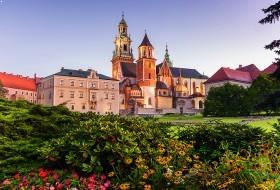Auschwitz Tour from Krakow
Our travel agency specializes since 2004 in organising Auschwitz Tour from Krakow. We cooperate only with licensed drivers and the most highly regarded professional museum guides. Transport in our comfortable air-conditioned vans will help you avoid crowded tour buses and long queues. In addition, we offer a range of popular tours of Krakow and Malopolska region.
Auschwitz Birkenau Museum is the main destination for millions of tourists visiting Krakow. It is the most famous rememberance in the world, a remnant of one of the two most horrible regimes in the history of mankind – national socialism.
Visiting Auschwitz is a spiritual journey into the times of World War II, the times when human life was worthless and the extermination of Jews and other „worse” nationalities was the main task for the German state authorities. Visiting Auschwitz leaves a scar on every visitor; seeing the gas chambers, the watchtowers, the death block demonstrates clearly how life ended for many Jews, Poles, Russians, Gypsies and others - millions of innocent victims of the Nazi regime who found themselves in Auschwitz just because they were born in families that were considered politically incorrect.
The best time to take the Auschwitz Tour and quietly meditate is autumn or early spring when there aren't many tourists yet. Although summer is a popular season to visit both Krakow and the concentration camp, we do not recommend it for tourists who want to experience such a visit in a more personal way because Auschwitz is very crowded at this time of year.
Auschwitz was the first Nazi German concentration camp founded in occupied Poland and also the largest of all the camps organized by the Hitler's regime. The reason for its creation was the overcrowding of prisons for Polish people arrested by the German police. During the construction works, nearly 10,000 Poles were expelled from the nearby villages. Originally, Auschwitz was not planned as any significant camp in the Nazi terror system, but soon it became the largest point for the elimination of Jews. The camp was a government-controlled institution, financed by the country's budget. In 1944, Auschwitz consisted of three main parts: Auschwitz I with 16,000 prisoners, Auschwitz II - Birkenau with the largest gas chambers in Europe and 90,000 prisoners, and Auschwitz III - Monowitz with 10,000 prisoners. The main complex was supported by dozens of smaller sub-camps with over 20,000 prisoners that provided free labour force to work on farms and in industry.
In late 1944, the Germans started to wipe out the evidence of their crimes by burning files, blowing up gas chambers and burning depots with property left behind by the victims. In January 1945, the units of the Soviet Red Army approached Oświęcim. In the meantime, Germans organized the Death March for 56,000 prisoners in an attempt to take them to concentration camps in the interior of the Third Reich. Nearly 10,000 of them died during this journey. At the end of January the camp was liberated with only 7,500 exhausted and sick inmates left behind.























